Vill du ha en säker plats där du kan experimentera med din WordPress-webbplats utan att vara rädd för att förstöra något på din live-webbplats?
Att flytta din WordPress-webbplats till en lokal server på din dator är enligt vår mening den perfekta lösningen, särskilt för utvecklare, designers eller WordPress-nybörjare.
Genom att installera WordPress på din dator (lokal server) kan du enkelt lära dig WordPress och testa saker. När du flyttar en live WordPress-webbplats till en lokal server kan du experimentera med samma data som din live-webbplats.
I den här artikeln visar vi dig hur du enkelt flyttar en live WordPress-webbplats till en lokal server.
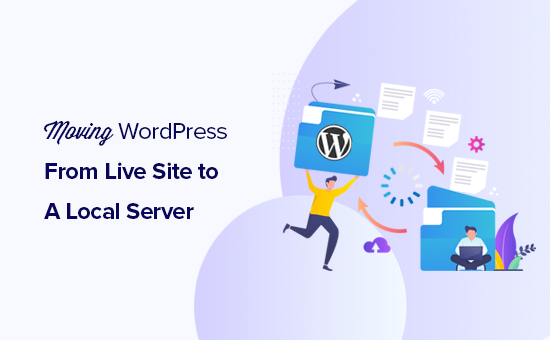
Varför och vem skulle vilja flytta en live WordPress webbplats till en lokal server?
Om du har drivit en WordPress-webbplats under en tid kanske du vill testa nya teman eller ett plugin. Om du gör detta på en live-webbplats kan det dock leda till en dålig användarupplevelse för dina användare.
För att undvika detta skapar många användare en kopia av sin WordPress-webbplats på en lokal server för att testa nya teman, plugins eller göra utvecklingstester.
På så sätt kan du skapa ditt tema med allt ditt innehåll och testa alla funktioner utan att behöva oroa dig för att din webbplats ska gå sönder. Många användare kopierar sin webbplats till en lokal server för att öva sina WordPress- och kodningskunskaper med faktiska webbplatsdata.
Även om du kan göra alla tester med dummy-innehåll i WordPress, ger verkliga webbplatsdata dig en bättre visuell representation av hur dessa ändringar kommer att se ut på din live-webbplats.
Förberedelser för att flytta en lokal webbplats till en lokal server
Först måste du se till att du alltid säkerhetskopierar din WordPress-webbplats. Det finns flera bra plugins för säkerhetskopiering av WordPress som du kan använda.
För det andra måste du installera en lokal servermiljö på din dator. Du kan använda WAMP för Windows och MAMP för Mac. När du har ställt in miljön måste du skapa en ny databas med phpMyAdmin.
Besök bara följande URL i din webbläsare för att starta phpMyAdmin.
http://localhost/phpmyadmin/
http://localhost:8080/phpmyadmin/
Härifrån klickar du på fliken “Databaser” och skapar en ny databas. Du behöver den här databasen för att senare kunna packa upp data från din live-webbplats.

Du är nu redo att flytta din live WordPress-webbplats till en lokal server.
Metod 1. Flytta live WordPress-webbplats till lokal server med hjälp av plugin
Den här metoden är enklare och rekommenderas för alla användare.
Det första du behöver göra är att installera och aktivera pluginet Duplicator. För mer information, se vår steg för steg-guide om hur du installerar ett WordPress-plugin.
Med Duplicator kan du enkelt skapa ett duplicerat paket av hela din webbplats. Det kan användas för att flytta din WordPress-webbplats till en ny plats och kan också användas som ett backup-plugin.
Obs: Det finns en gratis version av Duplicator som du kan komma igång med. Duplicator Pro kommer dock med obegränsade säkerhetskopior och mer avancerade funktioner.
Efter aktivering, gå till Duplicator Pro ” Säkerhetskopior från din WordPress admin sidofält. För att skapa ett nytt paket måste du klicka på knappen “Lägg till nytt”.
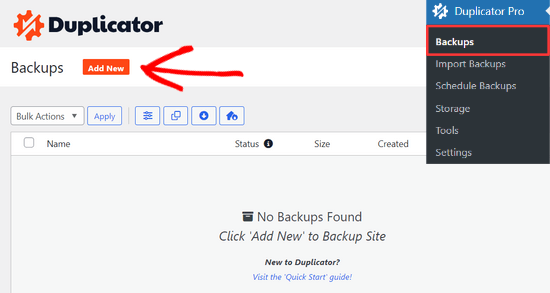
Duplicator startar sedan guiden för säkerhetskopiering.
Först måste du ange ett namn för ditt backup-paket. Du kan också använda de dynamiska taggarna för att automatiskt skapa ett namnformat som datum och webbplatsens titel.

Expandera sedan avsnittet “Storage” och välj en lagringsplats.
I den här handledningen använder vi standardplatsen. Du kan klicka på länken “Lägg till lagring” för att lägga till en ny plats, som Dropbox eller Google Drive, om du vill.
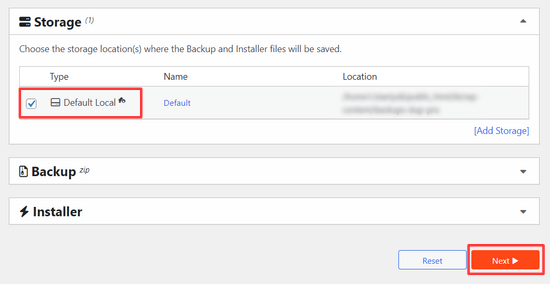
Klicka på knappen “Nästa” för att fortsätta.
Pluginet kommer sedan att skanna din webbplats och köra några bakgrundskontroller. Det kommer sedan att visa dig en sammanfattning av dessa kontroller.
Om allt ser bra ut klickar du på knappen“Skapa säkerhetskopia” för att fortsätta.
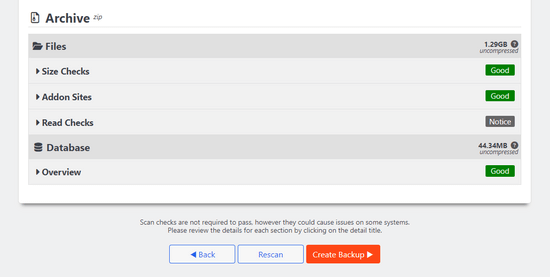
Duplicator kommer nu att skapa ditt webbplatspaket.
När du är klar ser du en zip-fil med arkiv som innehåller alla dina webbplatsdata och en installationsfil. Du måste ladda ner båda filerna till din dator.
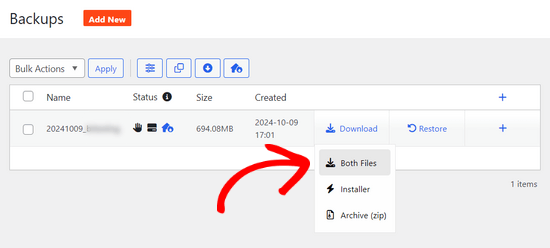
Du är nu redo att packa upp och installera dessa filer på din lokala server.
Först måste du skapa en ny mapp i den lokala serverns rotmapp. Det är den mapp där den lokala servern lagrar alla webbplatser.
Om du till exempel använder MAMP kommer det att vara /Applications/MAMP/htdocs/mappen. Alternativt om du använder WAMP, då skulle det vara C:\wamp\www\ mapp.
I den här mappen kan du skapa nya mappar för varje ny webbplats som du vill importera eller skapa på din lokala server.
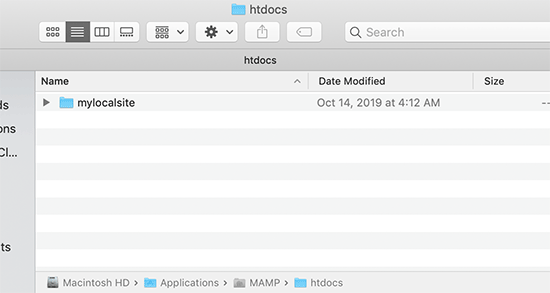
Därefter måste du öppna mappen som du skapade för din lokala webbplats och sedan kopiera och klistra in både arkivets zip-fil och installationsskriptet som du hämtade tidigare.
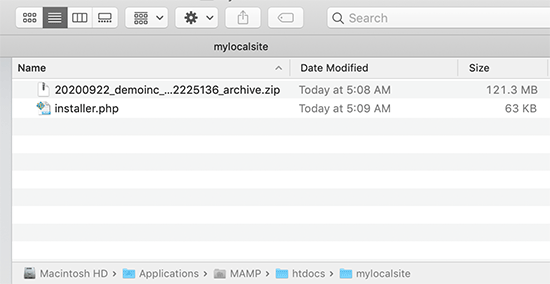
För att köra installationen måste du öppna skriptet installer.php i din webbläsare.
Om du t.ex. klistrade in båda filerna i mappen /mylocalsite/ kommer du åt dem i din webbläsare genom att besöka http://localhost/mylocalsite/installer.php.
Du kommer nu att se installationsskriptet för Duplicator så här:
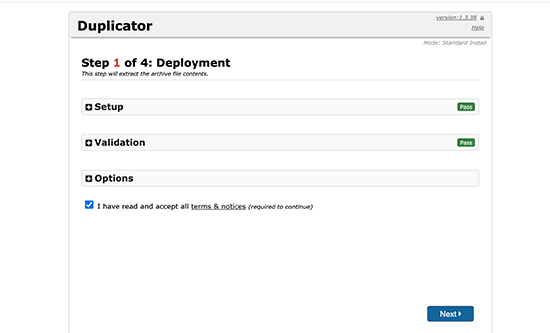
Klicka på knappen “Nästa” för att fortsätta.
Duplicator packar nu upp arkivets zip-fil och ber dig ange databasinformationen för din lokala webbplats. Detta är den databas som du skapade tidigare.
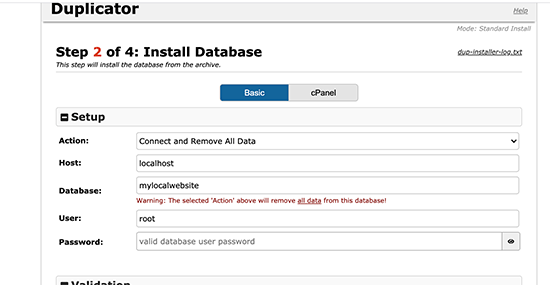
Servernamnet är nästan alltid localhost och användarnamnet är root. I de flesta fall har din lokala serverinstallation inget lösenord för root, så du kan lämna den tom.
Längst ner på sidan finns en “Test Database”-knapp som du kan använda för att kontrollera att databasinformationen är korrekt.
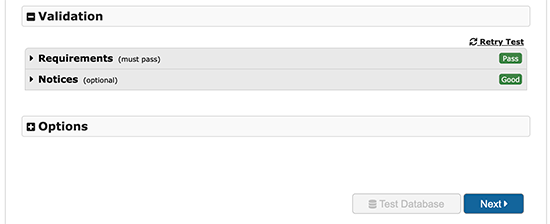
Om allt ser bra ut klickar du på knappen “Nästa” för att fortsätta.
Duplicator kommer nu att importera din WordPress-databas. Därefter ber den dig att dubbelkontrollera den nya webbplatsinformationen som den automatiskt har upptäckt.
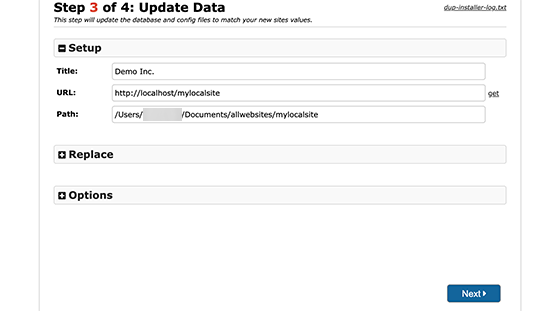
Klicka på knappen “Nästa” för att fortsätta.
Duplicator kommer nu att avsluta installationen och visa dig en knapp för att logga in på din lokala webbplats. Du använder samma WordPress-användarnamn och lösenord som du använder på din live-webbplats.
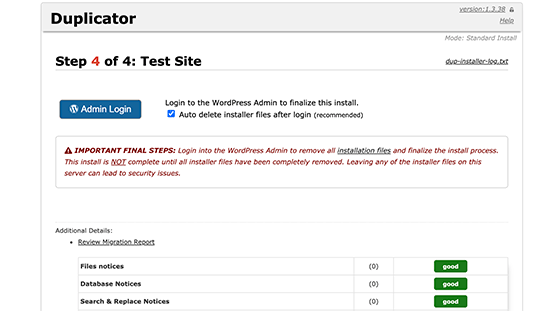
Det var allt, du har lyckats flytta din live-webbplats till den lokala servern.
Metod 2. Flytta en live WordPress-webbplats manuellt till en lokal server
Om insticksprogrammet inte fungerar för dig kan du alltid flytta din live-webbplats manuellt till en lokal server. Det första du behöver göra är att säkerhetskopiera din webbplats manuellt från ditt WordPress-värdkonto.
Steg 1. Exportera WordPress-databasen för din live-webbplats
För att exportera WordPress-databasen för din live-webbplats måste du logga in på din cPanel-instrumentpanel och klicka på phpMyAdmin.
Obs: Vi visar skärmdumpar från Bluehost-instrumentpanelen.
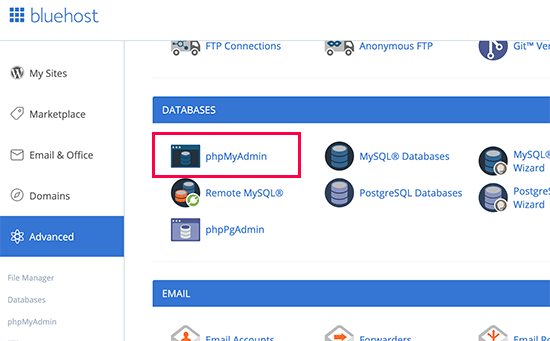
Inuti phpMyAdmin måste du välja den databas du vill exportera och sedan klicka på exportfliken längst upp.
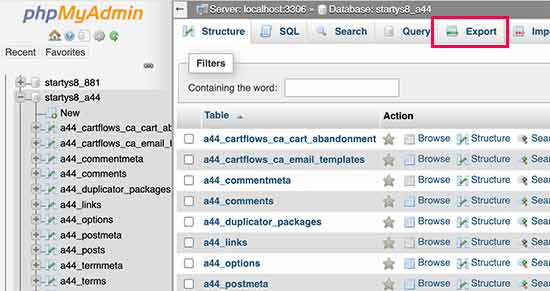
phpMyAdmin kommer nu att be dig att välja antingen snabb eller anpassad exportmetod. Vi rekommenderar att du använder anpassad metod och väljer zip som komprimeringsmetod.
Ibland kan WordPress-plugins skapa egna tabeller i din WordPress-databas. Om du inte längre använder det insticksprogrammet kan du utesluta dessa tabeller med den anpassade metoden.
Lämna resten av alternativen som de är och klicka på “Go” -knappen för att ladda ner din databasbackup i zip-format.
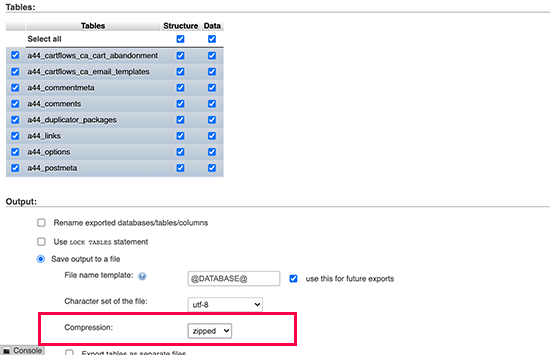
phpMyAdmin kommer nu att ladda ner din databasfil. För mer information, se vår handledning om hur du säkerhetskopierar din WordPress-databas manuellt.
Steg 2. Ladda ner alla dina WordPress-filer
Nästa steg är att ladda ner dina WordPress-filer. För att göra det måste du ansluta till din WordPress-webbplats med hjälp av en FTP-klient.
När du är ansluten väljer du alla dina WordPress-filer och laddar ner dem till din dator.
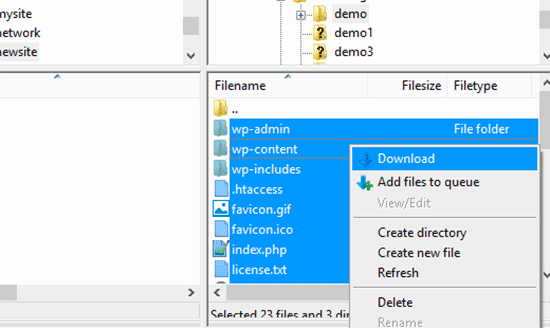
Steg 3. Importera dina WordPress-filer och din databas till den lokala servern
När du har laddat ner dina WordPress-filer måste du skapa en mapp på din lokala server där du vill importera den lokala webbplatsen.
Om du använder WAMP vill du skapa en mapp i mappen C:\wamp\www\ för din lokala webbplats. MAMP-användare måste skapa en mapp i mappen /Applications/MAMP/htdocs/.
Därefter är det bara att kopiera och klistra in dina WordPress-filer i den nya mappen.
Därefter måste du importera din WordPress-databas. Öppna helt enkelt phpMyAdmin på din lokala server genom att besöka följande URL:
http://localhost/phpmyadmin/
Eftersom du redan har skapat databasen tidigare måste du nu markera den och sedan klicka på fliken “Import” högst upp.
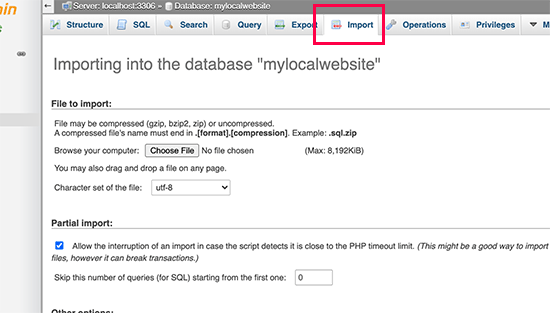
Klicka på knappen “Choose File” för att välja och ladda upp den databasexportfil som du laddade ner i det första steget. Därefter klickar du på knappen “Go” längst ner på sidan.
phpMyAdmin kommer nu att packa upp och importera din WordPress-databas.
Nu när din databas är klar måste du uppdatera webbadresserna i din WordPress-databas som hänvisar till din live-webbplats.
Du kan göra detta genom att köra en SQL-fråga i phpMyAdmin. Se till att du har valt din lokala webbplats databas och klicka sedan på SQL.
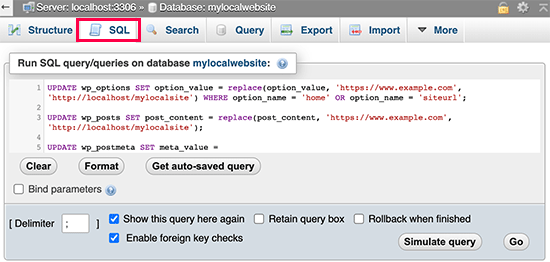
I phpMyAdmins SQL-skärm kopierar och klistrar du in den här koden, se till att du ersätter example.com med din live-webbplats URL och http://localhost/mylocalsite med den lokala serverns URL för din webbplats.
UPDATE wp_options SET option_value = replace(option_value,'https://www.example.com','http://localhost/mylocalsite') WHERE option_name ='home'OR option_name ='siteurl';UPDATE wp_posts SET post_content = replace(post_content,'https://www.example.com','http://localhost/mylocalsite');UPDATE wp_postmeta SET meta_value = replace(meta_value,'https://www.example.com','http://localhost/mylocalsite');
Den här frågan ersätter referenser till webbadressen till din live-webbplats från databasen och ersätter den med webbadressen till det lokala webbhotellet.
Steg 4. Uppdatera filen wp-config.php
Det sista steget är att uppdatera filen wp-config.php på din lokala webbplats. Den här filen innehåller WordPress-inställningar, bland annat hur du ansluter till din WordPress-databas.
Gå bara till mappen där du installerade WordPress på din lokala server och öppna sedan wp-config.php-filen i en textredigerare som Notepad.
Ersätt databasnamnet med det som du skapade i phpMyAdmin på ditt lokala webbhotell.
Därefter ersätter du databasens användarnamn med ditt lokala MySQL-användarnamn, vanligtvis är det root. Om du har angett ett lösenord för MySQL-användaren root på ditt lokala webbhotell anger du det lösenordet. Annars lämnar du den tom och sparar dina ändringar.
/** The name of the database for WordPress */define('DB_NAME','database_name_here');/** MySQL database username */define('DB_USER','username_here');/** MySQL database password */define('DB_PASSWORD','password_here');
Du kan nu besöka din lokala webbplats i ett webbläsarfönster genom att ange URL:en på följande sätt:
http://localhost/mylocalsite/
Ersätt “mylocalsite” med namnet på den mapp där du har kopierat dina WordPress-filer.
Det var allt, din live WordPress-webbplats är nu kopierad till din lokala server.
Vi hoppas att den här artikeln hjälpte dig att lära dig hur du enkelt flyttar en live WordPress-webbplats till en lokal server. Du kanske också vill läsa vår guide om hur du enkelt skapar en staging-webbplats för WordPress för testning, eller hur du flyttar en WordPress-webbplats från lokal server till live-webbplats.
If you liked this article, then please subscribe to our YouTube Channel for WordPress video tutorials. You can also find us on Twitter and Facebook.





Joseph
Hi, just came across this tutorial today, I found out about some of the steps from other tutorials, but my problem is with the SQL Query. I get the error # MySQL returned an empty result set (i.e. zero rows). I followed all your steps about changing site names etc but cant work this one out and so obviously i cant then connect to the local site. I used the Duplicator before on another site but it wont work so good on this one because of all the images on my photo site, ie timeout issues. Kinda going around in circles here, so help would be good.
Thanks,
Joseph
Yarina
Joseph, check that the table prefix on the SQL tables you are working with are the same. I had this issue before when I didn’t realize that the theme I was copying from had a non typical prefix (wp_extra-text instead of just wp_). When you create the new db on phpMyAdmin, make sure that the prefix matches that of the old db. Hope this helps!
Alan OldStudent
I tried using Duplicator, and that worked with one minor glitch. So then I dropped the database and tried the manual method. All steps proceeded well until it came time to import. I recreated the database and went to import. Afterwards, I got this error message: “#1064 – You have an error in your SQL syntax; check the manual that corresponds to your MySQL server version for the right syntax to use near ‘default’, ‘This is the default profile, used when no profile is specified.’, ‘a:’ at line 7”
To me that looks like gobbledygook. Do you have any idea what went wrong and how I can do the import manually?
Regards,
Alan
WPBeginner Support
This could be a syntax error or conflict caused by using different versions of MySQL. To solve this, when exporting your database choose the same MySQL version as your local install. Also make sure that you are using the same character set for both database tables.
Admin
Em Cloney
Just a quick thing I noticed: the Duplicator file is called “installer.php” rather than “install.php”.
Ben
I noticed the same thing. Great article, though. So glad I heard about this plugin from you guys.
wpva
Hi I decided to do it manually
I created a database for my WordPress site on my local server and tried to import the database that I downloaded before to my computer but im getting this error message:
SQL query:
—
— Database: `aguilar_jmln1`
—
— ——————————————————–
—
— Table structure for table `gm_AnythingPopup`
—
CREATE TABLE IF NOT EXISTS `gm_AnythingPopup` (
`pop_id` int(11) NOT NULL,
`pop_width` int(11) NOT NULL DEFAULT ‘380’,
`pop_height` int(11) NOT NULL DEFAULT ‘260’,
`pop_headercolor` varchar(10) NOT NULL DEFAULT ‘#4D4D4D’,
`pop_bordercolor` varchar(10) NOT NULL DEFAULT ‘#4D4D4D’,
`pop_header_fontcolor` varchar(10) NOT NULL DEFAULT ‘#FFFFFF’,
`pop_title` varchar(1024) NOT NULL DEFAULT ‘Anything Popup’,
`pop_content` text CHARACTER SET utf8 COLLATE utf8_bin NOT NULL,
`pop_caption` varchar(2024) NOT NULL DEFAULT ‘Click to open popup’
) ENGINE=MyISAM AUTO_INCREMENT=2 DEFAULT CHARSET=utf8;
MySQL said:
#1046 – Aucune base n’a été sélectionnée
Kin
It is saying that no database was selected.
Yeah I got that as well.
You need to make sure that you clicked on a database before hitting the ‘import”, if not the admin tool will try to import the .sql file on nothing!!
TMo
Wonderful tutorial on how to manually go through this process. Thank you for the clear directions and photos!
Shane Levine
Hi, is Duplicator an acceptable method for keeping a backup website? I have been using BackWPup but it looks like Duplicator also allows you to create a backup…
Dennis Crayon
Hi I am not sure if I just got lucky but I was able to download and setup the local version quickly. The only problem I am having is that I have to set permalinks to default which is fine locally will I be able to set them back to post name later when I push the whole thing live? Thanks just getting this far is great
WPBeginner Staff
Yes, you can change permalinks after putting your site live.
Felix
Dennis, I am new to wordpress but I have so far learnt key configuration issues. Could you lease hel on changing permalinks from default to post name?
Iftikhar Raja
Just an observation to share.
If you choose custom structure as permalink, it might not work. The work around is to chose default permalink and save the changes. It worked for me after several hours of head scratching
Hope it helps
Mario
If you’re using WAMP you need to turn on mod_rewrite to enable custom permalinks.
Click Wamp -> Apache -> Apache Modules -> rewrite_module
WPBeginner Staff
It is usually enabled by default.
isboleas
Perfect! I did it manually just in wp-config.php must change and the line
/** MySQL hostname */
define(‘DB_HOST’, ‘127.0.0.1 ‘);
With ip appear in phpmyadmin in left up corner.
Anindyo Yudhistiro
I’ve followed all the steps, but I still can’t see my database in my local wp. I still only have Hello World post.
I’ve imported it, change all the url’s, and many row has already affected.
Keith Davis
I used the manual method but the SQL query wouldn’t work for me.
I had to go into the wp-options and change url in siteurl and home table and then all was fine.
Keith Davis
Hi guys
The Duplicator method looks good.
Do you know how much free disc space you need to create the packages?
Nana
Any ideas why it gives me a “Welcome to the famous five-minute install” screen?
WPBeginner Staff
It is possible that your WordPress URL and Site URL are set to localhost/xammp. If you can access the admin area go to settings and set it to your WordPress install directory.
Je
I checked and it’s definitely not set to that. It is so strange!
Je
I figured it out. It was the W3 cache in the htaccess file causing problems. Thanks for you help and for this awesome tutorial!
Jen
Great tutorial, I did everything exactly like you said….I thought it was working until I tried to change the theme and it wouldn’t change. Then I started trying to navigate to other pages and it took me to localhost/xammp. Everytime. Any ideas?
dion
Hi. I did all of this(using the manual option, but when I click on any option, ie login or one of the menu options, I get “the requested URL … was not found on this server”
wagster
If you copy the SQL query straight off the screen above, you will get the line numbers as well, which will throw an error like the above. Click ‘View source’ and copy the clean code from there.
MrDev
Thanks for this article. I tried the manual route of moving a WordPress site to localhost, however my stylesheets are not loading. For some reason the ‘href’ is not being set on all my stylesheets. Any idea what might be going on?
WPBeginner Staff
We would feel more confident recommending BackupBuddy for backups.
NikkiC4lyf
Would you recommend using the Duplicator plugin for doing backups as well as moving sites?
Kin Tatsu
Great tutorial! The problem I’m having is when I login to to wp-admin with the same login and password I used for my live site I get “ERROR: Invalid username. Lost your password?” The username and password are correct for the live site but incorrect for the localhost site. I tried to retrieve password with my email address but it says that my email address is not registered. Any ideas?
pbr
I have only one word about this steps…AAWWEESSOOMMEE!!!!
StefsterNYC
Did you check your Prefixes?
pels
got same error
StefsterNYC
You may have missed a table or something. Do a search for the old prefix. Also make sure you’re using a fresh new WP-CONFIG. I find that sometimes that messes things up.
StefsterNYC
Sorry for the delay Mark. Not sure I understand your question. Hopefully I can answer something here.
If you started with a config file and it originally started with the wp_ and you didn’t use a custom one you’ll be fine. Just remember the config has to match the DB. If you worked locally and are migrating everything to a live site and you use the same DB and same Config that you worked locally with everything should be fine. Just remember to change Username, Password and Hostname.
The key here to remember here is Prefixes. So many people teach you how to do this and that but they miss the one thing that can mess it all up for you. And that is the Prefix.
And User Roles, if missed can cause a major headache when adding Admins manually. So be careful when changing and working with prefixes. They are absolutely a great way to tighten up WP sites. I highly recommend using a custom prefix always. dbh_234_ something like that is a great way to protect your site(s).
WPBeginner Staff
If your live site’s mysql host is not localhost, then you need to change it to localhost. You may also need to change the database name to the database on your local computer. Same goes for DB username which is usually root on local servers, and db password which is usually blank.
Mark
Hi just to be clear the password in the config.php file should be the same as the one you use for myphpadmin? because that seems to work for me?
StefsterNYC
Great tutorial. I believe one thing was missed. Prefix. For those of you that use a prefix in the config, make sure when you query the db you change the wp for the query to your prefix. Otherwise your query won’t reset the urls correctly.
Mark
If I have a local install and I move the database live, the prefix will remain the same correct? Do I need to do anything?
Cypherinfo
Error 404: Object not found: The requested URL was not found on this server. The link on the referring page seems to be wrong or outdated. Please inform the author of that page about the error.
If you think this is a server error, please contact the webmaster.
” I followed all of the steps you wrote.
Sophie
These instructions are exactly what I needed. Thank you!!!
However, I seem to have encountered a problem…
When updating the URLs in my database for those of the local server, it returns a #1064 – error in your SQL syntax near line 3. Could you possibly suggest a solution?
Would I need to include the port number when updating the http://localhost/ part of the code?
Please Help!!
Vtin
One more newbie trouble here! Sorry for the inconvenience.
Of course, I think I’ve done everything correctly (probably not). When I try to access the site via localhost, in the screen appears the index.php file line by line, instead of loading it.
Any ideas?
W
This was fantastic. Super quick and worked exactly as intended.
Paul Sahota
Can you please show how to move a live wordpress site to local using backup buddy on mac using MAMP. I have tried multiple times but it does not work for me. I can easily do the opposite.
thanks
Jeremy
After transferring the live site to my local server (wamp), I navigate to the destination in browser and get a “Not Found” wordpress error. The site’s navigation loads though and when clicked it takes me to the live site. Am I missing something rudimentary?
Kin
I am getting the same thing. I followed all the steps. Then came back to check again, but the error remains. I am seeing that a couple of people above had the same problem as well. Any idea guys of why this is happening?
Sinuhe
Thank you!!! I just finished moving my site and a subdomain to a new hosting service and it worked like a charm. I am no techie, actually I am philosopher I really appreciate you taking the time to explain this info in detail.
I really appreciate you taking the time to explain this info in detail.
Sam
Hey, I did everything the same way you said in manual method.
after setup,
I can see homepage of my website on local server.
But when I try to navigate to other page, I get following error:
“Not Found: the requested URL /test/logistics was not found on this server.”
Please help
Bill
I just ran into the same issue. I went into site/wp-admin. Then went to Setting > Permalinks and just clicked Save Changes. It updated something and all of my links work.
Look at that! My first contribution to the community.
Isabela Santos
thank you! But I had to disable it for it to work…
Mark
Brilliant!
John
Awesome. Worked great! Thanks for posting this.
Natalia
Hi,
I followed your tutorial on doing it manually to the T, but I still get an error message. I am pulling my hair, here…
I’m pretty new to WP and I still have to figure out how to actually enter the new content and modify the files… but I can’t even get it to work locally
This is the message I get:
“Error establishing a database connection”
Which I don’t understand, because I did everything as you said in your tutorial.
Help, please!!
Natalia
Tried it all over again a second time and still same error message… I’m going crazy
Natalia
I even tried in a remote server and I got the same error message. I don’t know what I’m doing wrong… there must be a path somewhere that I’m forgetting about and it’s just not reading the right db…
Someone, please, help!!
WPBeginner Support
Natalia, the most common cause for this error is incorrect database information. On your live site, you need to edit your wp-config.php file. Make sure that the database information in this file matches the database you have created for your live site.
Admin
Kathi Kostiuk
Thank you, your site is super helpful. New to WP, inherited a site, got it localhost so I can learn/test. When trying to ‘upload’ a pic, get this: C:/wamp/www/testsite/wp-content/uploads. Is its parent directory writable by the server? No errors shown in phpMyAdmin, permissions on folders, users look right. Could you possibly direct me to a solution? Have looked everywhere I can think of. Thanks.
WPBeginner Support
When you moved the site to localhost, did you change the siteurl and homeurl options? If you didn’t then you need to add these two lines to your
wp-config.phpfiledefine('WP_HOME','http://localhost/yoursite');define('WP_SITEURL','http://localhost/yoursite');1-click Use in WordPress
Admin
Kathi Kostiuk
Thank you, will do that.
Julie Rondeau
Hi,
Great tutorials! Thank you, however i keep getting an “Unknown” Error code 0 from the Duplicator Plugin when trying to create the packages. Is there any other way you could recommend? Any help would be really appreciated.
Thank you so much,
Best from Paris.
J.
WPBeginner Support
You can also manually backup your localhost site and restore it on live server.
Admin
Rehan
Best tutorial ever!!
Ashley
Hi! Thank you so much for your great tutorials! Everything worked out great, but I when I was supposed to “resave permalinks” it wouldn’t let me login. I got that fixed and I am logged in now, but where do I go to resave them now that I don’t have that pop up? I’m assuming this is why when I try to click on posts it gives me a “not found page” ? Thanks in advance!
WPBeginner Support
You can save permalinks from Settings » Permalinks.
Admin
Jesse
Can I ask how you fixed the login problem? I’m getting the same issue.
Yarina
Hi! This all worked great until I had to login to the wp dashboard, my login didn’t work and even after changing it manually in the users table, I couldn’t log in, any ideas…?
Angela
Thank You! I’ve been trying to do this for some time now. I’ve watch several YouTube videos but could not get it to work correctly. This was so easy….the best thing ever. Again thanks!
Ivan
Hi,
I followed your instructions to the letter (and sing lol), but was not successful. I think it has something to do with WP installation. I have not installed it, just copied it.
Brett Golding
Didn’t work for me just ended up with a blank white home page after I ran the program. Re tried 3 times.
WPBeginner Support
Checkout how to resolve white screen of death issue.
Admin
Jason Moore
Thank you! This is was too easy!
ron
Hi, I’m trying to do exactly this, but I get a 500 Internal Server Error right after I put the database details and hit the Run Deployment button, I get the progress animation and after about 10 or 15 seconds I get the error.
I was looking at the error logs located at C:\wamp\logs and I could only find this line that seemed somewhat relevant: “Invalid command ‘RewriteOptions’, perhaps misspelled or defined by a module not included in the server configuration”.
I’ve successfully used duplicator in the past, but going from webserver to another webserver.
Any ideas?
WPBeginner Support
Please take a look at our guide on how to fix 500 internal server error in WordPress.
Admin
Usama Noman
Thanks, seems like this is a tutorial posted upon my request Thanks guys you are doing good.
Thanks guys you are doing good.
WPBeginner Support
Yes it is Usama. Thank you for suggesting it to us.
Admin
Jamie Mannion
Good guide, but I think you missed the part where you update wp-config.php with the new database details – name is the new name, username is ‘root’ and password is empty.
I tried it manually and it all looks good but the links take me to the WAMP server configuration page, even though the URLs are updated – can’t figure it out. I can get the home page and admin, but that’s it. Cheers!
WPBeginner Support
Thanks for pointing out updating wp-config.php thing. We have updated the article.
As for your redirection issue. Try deleting .htaccess file from wordpress installation on your localserver.
Admin
Jamie Mannion
Awesome, thanks! I removed the .htaccess, then visited the permalinks option page and saved and now we’re good! I should admit, the only reason I knew about the wp-config.php settings is because I’ve read your previous articles. Keep up the great work!
Kin
I put a question earlier today, but this worked out for me great.
Thank you.
Shahraar Khan
I do this manually. Just zip the files from the server and download it… export the database and replace all the links in my text editor. just a 5 min work.. But anyhow your tutorial is also a very good alternative.